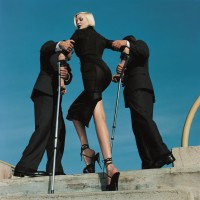Shoe Fact: Why We Buy Shoes We’re Never Going to Wear

Windows on the sole: why we buy shoes we’re never going to wear
As Shoes: Pleasure and Pain opens at London’s V&A, Jane Shilling explores why our footwear carries such emotional weight.
A month before the opening of the Victoria and Albert Museum’s exhibition “Shoes: Pleasure and Pain” a timely row blew up at the Cannes Film Festival, where several women reported being refused entry to screenings because they were not wearing high heels. The festival director, Thierry Frémaux, denied the ban – but in vain: the Riviera air was busy with the chirping of outraged tweets. The director Denis Villeneuve promised that he and his stars Josh Brolin and Benicio del Toro would “walk the stairs in high heels” to the premiere of his film Sicario (they didn’t). Villeneuve’s leading lady, Emily Blunt, added: “I think everyone should wear flats, to be honest. We shouldn’t wear high heels anyway . . . I just prefer wearing Converse sneakers.” (She didn’t.)
The diverting Cannes skirmish perfectly exemplified the paradoxes that swarm around the subject of shoes. No other article of human clothing attracts so many contradictory narratives, or offers such fantastically wayward disconnections between function and form.
“Shoes are emotional,” says Helen Persson, curator of the V&A exhibition. “The body remembers things through shoes. They are containers for memory.” To tour the exhibition is to discover that footwear can be a receptacle not just of memory, but of a vivid spectrum of alternative interpretations. The same shoe, viewed from different perspectives, can appear an instrument of oppression or empowerment. It is an elision disturbingly represented by the 1995 Helmut Newton photograph on the cover of the exhibition catalogue, which shows the elegant dominatrix figure of the model Nadja Auermann, feet tightly laced into towering, weapon-like black stilettos, supporting herself on crutches as she is manhandled up a flight of steps by a couple of faceless, black-suited men. Their ambiguous poses might equally convey assistance or compulsion.
Duality is deeply embedded in the elemental technology that separates our feet from the ground on which we tread. As a container for spiritual meaning, footwear is laden with wishes, both benevolent and malign. Shoes can redeem, or they can punish. They can whisk their wearer seven leagues in a single step, transform a drudge into a princess, summon magical aid, or force her to dance until she begs for her feet to be cut off.
Buried on the threshold of a house, or thrown at a newly married couple, worn shoes invoke good fortune. But when in 2008 the Iraqi journalist Muntadhar al-Zaidi hurled his shoes at the then president George W Bush at a press conference in Baghdad, he intended the most grievous insult that he could devise. (A representation of the offending footwear later went on display at Mmuseumm, an ethnographic mini-collection housed in an old TriBeCa lift shaft).
The shoes displayed in the V&A show explore every permutation of human energy, from the fleet, ergonomic sophistication of Adidas’s 2014 Primeknit football boot to the fiercely constrained sexuality of Christian Louboutin’s Ballerina Ultima fetish stilettos, whose phallic high-arched dancer’s pointe is rendered perversely static by an impossibly high dagger heel. (Perversity has its precedents: Louboutin’s ballet pump references a tight-laced 19th-century “exhibition” boot with similar swelling arch and vertiginous, scarlet heel.)
As statements of individual style, shoes are eloquent conduits of character. An unexpected consequence of visiting this exhibition is that you find your gaze obsessively fixed at pavement level for days afterwards, unpicking the knotty semiotics of other people’s choices of footwear. Yet despite the captivating frivolity of the exhibits – the tottering white satin and silver lace mules worn by Marie Antoinette a year before her execution; the fabulously desirable 15th-century high-heeled riding boots in vivid jade shagreen; the heels moulded from Wedgwood jasperware; and the platform boudoir shoes handmade by the bespoke shoemaker Caroline Groves in silk satin and wood, each embellished with a powder-blue wing severed from a real (dead) parakeet and a solid silver claw – a certain melancholy hint of stories untold pervades the whole display.
Many of the shoes shown here have outlived their owners by centuries; even millennia, in the case of the gilded Egyptian leather platform sandal from 30BC that is the oldest exhibit. Such enviable objects as the velvet-lined shoe trunk once owned by the socialite Rita de Acosta seem freighted with ghostly secrets. Filled with exquisite shoes made of antique velvet, lace and silk, mounted on trees carved from the wood of old violins by the enigmatic Italian museum curator and shoemaker Pietro Yantorny, who took as long as six months to fashion a single pair of shoes, it is as rarified an expression of virtuoso craftsmanship as anything in the V&A’s concurrent “What Is Luxury?” show (runs until 27 September). Yet as Helen Persson points out, the value of shoes (unlike other precious artefacts – jewels, paintings, furniture) is fatally degraded by their function: “As soon as you put your foot in [a shoe], it’s ruined.”
Persson, a curator in the V&A’s Asian Department, had the idea for the show when she discovered a drawer full of ornately decorated Indian shoes and began to speculate about the messages their wearers intended to convey. That curiosity about meaning inspired the exhibition’s structure, which is thematically organised on two levels. The ground floor explores the emotional aspects of shoes: their coded narratives of power and identity. Then, following the footprints of a high heel, a brogue, trainers and a work-boot, visitors are guided upstairs to a mezzanine where shoemakers including Manolo Blahnik, Sandra Choi of Jimmy Choo and Caroline Groves discuss their craft in filmed interviews. X-rays bristling with nails and a deconstructed shoe reveal the secrets of shoemaking, and the nature of shoe obsession is explored through contemporary and historical collections, including some of Imelda Marcos’s notorious stash.
“Obsession with shoes is deeply embedded in us from fairy tales,” Persson says. “How they could transform you, help you reach a goal, live your life like a celebrity, if only you had those particular shoes.” Unlike with a dress, a hat, a bag or even a corset, every individual’s relationship with shoes is indelibly personal. Once worn, a shoe receives the imprint not just of its owner’s sole, but arguably also her soul.
The intimate connection between footwear and identity is a potent leitmotif in fairy tale and myth. Persson notes that versions of the Cinderella story are to be found across all cultures: one of the earliest was recorded in the 5th century BC by Herodotus in his Histories. (The episode of Sex and the City in which Carrie Bradshaw is mugged for her Manolos seems to be a rare reversal of the Cinderella narrative, with the shoes, rather than the heroine, as the ultimate object of desire.)
Red shoes carry a particularly problematic charge. Invariably magical, they sometimes symbolise love and protection – as in the case of the ruby slippers that transport Dorothy home from her adventures in Oz, or the little red boots that Hans Christian Andersen’s gentle heroine Gerda puts on as she sets out to rescue her playmate, Kay, from the emotionally frigid Snow Queen.
More often a flash of red in the region of the sole betokens deceit and transgressive desire, swiftly punished with mutilation and torture. Cruella de Vil, the Dalmatian-kidnapping villainess of Dodie Smith’s 1956 novel, The Hundred and One Dalmatians, wears a pair of “ruby-red shoes” beneath her “absolutely simple white mink cloak”. Cruella’s ghastly collection of furs (though not Cruella in person) is later ripped apart by jubilant Dalmatian puppies.
In Hans Christian Andersen’s horrible fairy story “The Red Shoes” the heroine, Karen, is too delicate to endure the clogs that chafe the flesh of her tender feet, and she secretly wears forbidden shoes of fine red leather to church. Her punishment is to be forced to dance in her aspirational scarlet footwear until she begs an executioner to cut off her legs with his axe.
The severed feet, still wearing the red shoes, dance away into the forest – that lawless place of dark secrets. Noritaka Tatehana’s 2011 Crystal Lady Pointe shoes, satin-laced, encrusted with scarlet crystals and poised on towering blocks, eerily evoke both Karen’s illicit shoes and the bloody stumps that remain when she is released from their demonic bondage.
If the act of putting on a shoe defines the frontier between the private and public worlds, it can also convey a coded message of defiance or subversion. Like the single high-heeled mule of blue-trimmed white satin that dangles insolently from the toes of the naked courtesan in Manet’s 1863 portraitOlympia, the over-the-knee patent-leather boots in which the Home Secretary, Theresa May, was photographed in March this year dropping a curtsey to the Queen (from the knee upwards, a monument of sturdy Tory respectability; from patella to sole, pure boudoir) challenge the onlooker with an eloquent, mute critique of what we might think we see.
Persson says that while working on the show she sometimes found that “people would confess to me over a cup of tea about their shoe behaviour”. It is hard to imagine anyone feeling the urge to admit a fetish for T-shirts over a mug of Earl Grey, or divulging a furtive passion for skirts over a dish of Lapsang Souchong. As objects of desire, shoes command by far the best narratives.
Caroline Groves, whose handmade shoes and bags inhabit an ambiguous realm between clothing and art, recalls producing a pair of shoes that became objects of fraught totemic significance for a client undergoing gender reassignment. In his autobiography The Naked Civil Servant, the writer Quentin Crisp gave an agonisingly comic account of cramming his feet into the tiniest shoes he could endure: “Both I and the shop assistant needed all the fortitude we could summon . . . For me, as for Hans Andersen’s little mermaid, every step was agony.”
In My Brilliant Friend, the first novel of Elena Ferrante’s fictional sequence about friendship and identity, the design and making of a pair of shoes offer Ferrante’s joint heroine Lila the tantalising possibility of an alternative future beyond the confines of her Neapolitan ghetto, before the shoes undergo a spiteful metamorphosis into the instrument of her subjection.
A belief in the transformative power of footwear is an experience familiar to anyone who has ever felt the mysterious pang of recognition – an alchemical flash, like falling in love – that precedes the reckless purchase of a superfluous pair of shoes. Often it isn’t even necessary to wear the impossible objects: the act of possession is enough.
In the recesses of my own wardrobe there lurks a tower of shoeboxes containing a dozen or more pairs of museum-quality Manolo Blahniks, acquired at sales over several decades and never worn. The blue satin dance shoes with rhinestone buckles; the tapestry slippers with vaguely disturbing vamps of black patent leather; the chinchilla-trimmed mules of flower-embroidered grey flannel lined in sky-blue kid: they wait patiently in the darkness for their interminably delayed debut. They are my other selves; the many different people I once fancied I might become – but never did.
One day, I suppose, I will eventually part with them: give them away to someone whose alternative futures, fixed only by a foot sized 36 and a half, still lie ahead of her. But not yet. For now, like the V&A’s 15th-century white-kid Venetian chopines; the Christian Louboutin sandals of black leather with hydrangea petals trapped in transparent acrylic soles; the tiny, brutal, flower-embroidered Chinese lotus shoes and the surprisingly hefty rose-pink 18th-century dance pumps whose insole is printed with the forthright legend “Edward Hogg Ladies’ Cheap Shoe Warehouse”, my unworn Blahniks remain poised between the pristine perfection of the cobbler’s last on which they were made, and a future in which to be worn would be their moment of glory – and their ruin.
“Shoes: Pleasure and Pain” runs at the Victoria and Albert Museum, London SW7, from 13 June to 31 January 2016. For more details visit: vam.ac.uk




